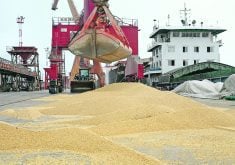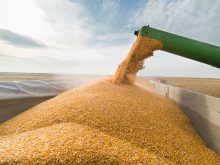Grain markets have become extremely sensitive to weather threats, leaping up last week at the threat of a heat wave and dropping back this week with forecasts of better growing conditions.
“Hot weather makes hot markets,” said Manitoba government grain market analyst Carol Gunvaldsen at the end of a week in which most commodity prices jumped on the Winnipeg and Chicago exchanges.
A rally started July 3 and continued to July 13, when prices dropped somewhat.
Between the beginning of July and July 16, November canola on the Winnipeg Commodity Exchange jumped 11 percent, October barley jumped 16 percent and feed wheat jumped 17 percent.
Read Also

Flax sector sees omega-3 opportunity
SASKATOON — A global shortage of omega-3 oils could be an opportunity for the flax sector, says an industry official….
Chicago December corn jumped eight percent and November soybeans increased about the same amount.
For more than a week, contract highs were being set every day.
However, prices in Chicago and Winnipeg dropped back on July 13 and 16 when weather forecasts improved. Rain was expected across substantial parts of the U.S. corn belt and rain was falling in Western Canada’s badly parched canola zones.
Analysts had expected that at some point the sizzling market would fall back while traders took profits.
But even with the July 16 reversal, some analysts said the markets appear to be more vulnerable to weather shocks than they have been for a long time.
“A run up in price like you have here will have all the buyers a little more sensitive to what’s going on,” said Charlie Pearson, an Alberta government grain markets analyst.
“At one point in time you wouldn’t get too worried because prices were either going down or flat, so you could hide in the weeds and not take too much notice.
“The market has shown us in the last couple of weeks that it can go up if it chooses to.”
Analysts said better weather in some areas doesn’t remove the threat to crops, which need more than one or two rainfalls to recover.
It may already be too late to save yields in some crops, since heat has struck canola, corn and soybeans at a critical time for yield setting.
Statcom Ltd.’s Growcanola newsletter said weather will continue to be a force that pressures prices up.
“Lower oilseed supplies worldwide and annual demand increases will see any weather problems quickly move prices higher,” it said.
“With oilseed prices worldwide, only recently moving off lows, there’s still plenty of upside.”















